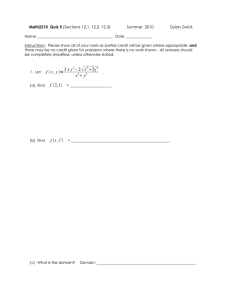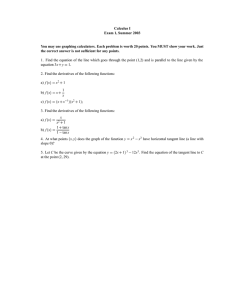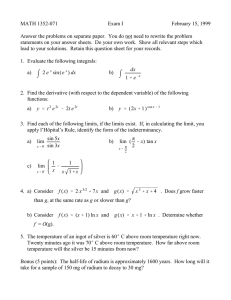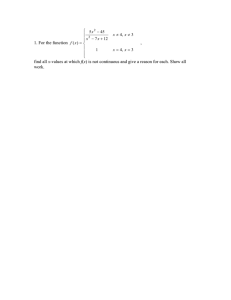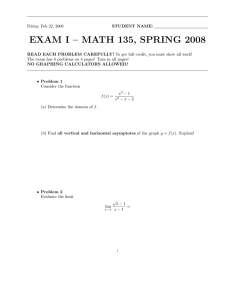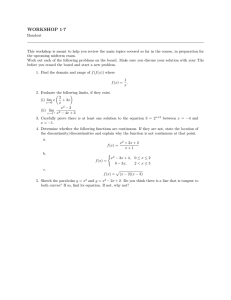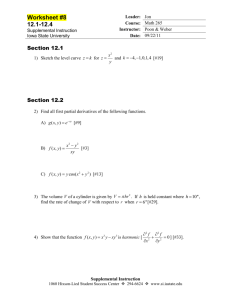1. Compute the following derivatives: (a) f e
advertisement
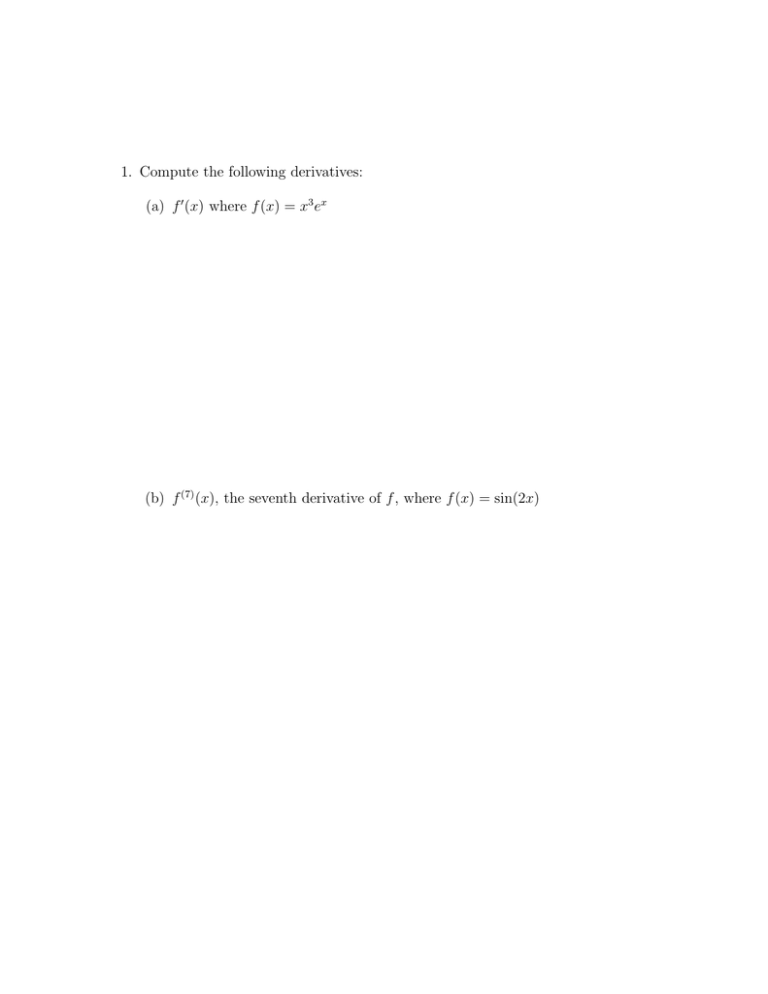
1. Compute the following derivatives: (a) f � (x) where f (x) = x3 ex (b) f (7) (x), the seventh derivative of f , where f (x) = sin(2x) 2. (a) Find the tangent line to y = 3x2 − 5x + 2 at x = 2. Express your answer in the form y = mx + b with slope m and y-intercept b. (b) Show that the curve defined implicitly by the equation xy 3 + x3 y = 4 has no horizontal tangent. d 3. (a) Use the DEFINITION of the derivative to compute dx � � x . x+1 (b) Compute the following limit: tan−1 (x) − π/3 √ 3 x− 3 lim √ x→ where as usual tan−1 (x) denotes the inverse tangent function. 4. Sketch the graph of the function y= x2 x . +1 Be sure to identify in writing all local maxs and mins, regions where the function is increasing/decreasing, points of inflection, symmetries, and vertical or horizontal asymptotes (if any of these behaviors occur). 5. A poster is to be designed with 50 in2 of printed type, 4 inch margins on both the top and the bottom, and 2 inch margins on each side. Find the dimensions of the poster which minimize the amount of paper used. (Be sure to indicate why the answer you found is a minimum.) 6. A highway patrol plane is flying 1 mile above a long, straight road, with constant ground speed of 120 m.p.h. Using radar, the pilot detects a car whose distance from the plane is 1.5 miles and decreasing at a rate of 136 m.p.h. How fast is the car traveling √ along the highway? (Hint: You may give an exact answer, or use the fact that 5 ≈ 2.2.) 7. Evaluate the following limits: (a) lim n→∞ �� n � 2i 1+ n i=1 � 2 n (b) 1 lim h→0 h � 2 2+h sin(x2 ) dx 8. Compute the following definite integrals: (a) � π/4 tan x sec2 x dx 0 (b) � 2 x ln x dx 1 9. Calculate the following indefinite integral: � x2 dx √ 9 − x2 10. The disk bounded by the circle x2 + y 2 = a2 is revolved about the y-axis to make a sphere. Then a hole of diameter a is bored through the sphere along the y-axis (from north to south pole, like a cored apple). Find the volume of the resulting “cored” sphere. (Hint: Draw a picture of the two-dimensional region to be revolved, and label parts of your picture to help set up the integration.) 11. The following integral has no elementary antiderivative: � 5 x e dx 1 x Use the trapezoid rule with two trapezoids and the following table of values (ac­ curate to one decimal place) to estimate this definite integral. x e /x x 1 2 3 4 5 2.7 3.7 6.7 13.6 29.7 (Hint: It may help to draw a very rough picture of the area under the curve you are computing, divided into two trapezoids.) 12. The rate of radioactive decay of a mass of Radium-226 (call it dm/dt) is propor­ tional to the amount m of Radium present at time t. Suppose we begin with 100 milligrams of Radium at time t = 0. (a) Given that the half life of Radium-226 is roughly 1600 years (half life is the time it takes for the mass to decay by half), find a formula for the mass of Radium that remains after t years by solving a differential equation. (b) Find the amount of Radium remaining after 1000 years. Simplify your answer using the fact that 2−10/16 ≈ .65 13. Cornu’s spiral is defined by the parametric equations � t x = C(t) = cos(πu2 /2)du �0 t y = S(t) = sin(πu2 /2)du 0 That is, the parametric equations are given by Fresnel functions we met earlier in the semester. Find the arc length of the spiral from t = 0 to a fixed time t = t0 . 14. (a) Find the Taylor series of ln(1 + x) centered at a = 0. (b) Determine the radius of convergence of this Taylor series. (c) Use the first two non-zero terms of the power series you found in (a) to approximate ln 3/2. (d) Give an upper bound on the error in your approximation in (c) using Taylor’s inequality. 15. (BONUS – Only attempt this problem if you are finished with the exam and have time to spare.) Prove or disprove the following statement: x < tan−1 (x) < x 1 + x2 for all x > 0. MIT OpenCourseWare http://ocw.mit.edu 18.01SC Single Variable Calculus�� Fall 2010 �� For information about citing these materials or our Terms of Use, visit: http://ocw.mit.edu/terms.
